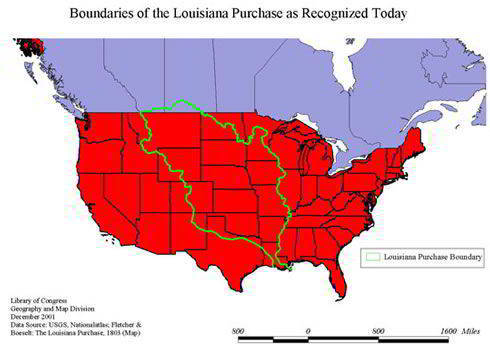Category: History Listing Date: 1889-11-02

South Dakota Statehood

The Louisiana Purchase
"Let the Land rejoice, for you have bought Louisiana for a Song." - - Gen. Horatio Gates to President Thomas Jefferson, July 18, 1803
National Archives and Records Administration
On Apr. 30, 1803, the United States signed a treaty effecting the purchasing of the Louisiana Territory from France. Over 2 million sq km (800,000 sq mi) of land extending from the Mississippi River to the Rocky Mountains was purchased for 60 million francs, or about $15 million.
Dakota Territory
On March 2, 1861, President James Buchanan signed the Organic Act creating the Dakota Territory, which originally included the area covered today by both Dakotas as well as Montana and Wyoming.
The name was taken from that of the Dakota or Sioux Indian Tribe. Beginning in 1877, efforts were made to bring Dakota into the Union as both a single state and as two states. The latter was successful and on November 2, 1889, both North and South Dakota were admitted. President Benjamin Harrison went to great lengths to obscure the order in which the statehood proclamations were signed, so the exact order in which the two states entered is unknown. However, because of alphabetical position, North Dakota is often considered the 39th state.

South Dakota's state government is organized into three branches - executive, legislative, and judicial. The Governor of is the chief executive officer of the state and is elected for a four-year term. The Governor of South Dakota may not serve for more than two terms in a row. William J. Janklow served two terms and was then later elected again.
Arthur Calvin Mellette was the last Dakota Territorial governor. When statehood split the Territory, Mellette became the first governor of South Dakota. Mellette, who served in the Civil War, came to Dakota on his own and was not appointed by the president.
Historically, South Dakota has elected mostly Republicans and few Democrats as Governor.
South Dakota's Governor did not have an official residence until 1925, when the state legislature purchased a small yellow cottage which served as the Governor's Residence until 1936.
